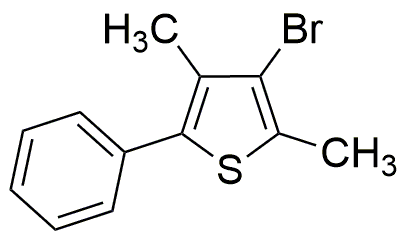3-Bromo-2,4-dimethyl-5-phenylthiophene is widely utilized in research focused on:
- Organic Electronics: This compound serves as a key building block in the synthesis of organic semiconductors, which are essential for developing flexible and lightweight electronic devices.
- Pharmaceutical Development: It is used in the design of novel pharmaceutical agents, particularly those targeting specific biological pathways, enhancing drug efficacy and specificity.
- Material Science: The compound plays a role in creating advanced materials with unique properties, such as improved conductivity and stability, beneficial for various industrial applications.
- Photovoltaics: It contributes to the development of organic solar cells, offering a more sustainable and cost-effective alternative to traditional silicon-based solar technology.
- Research in Organic Synthesis: This chemical is valuable in academic and industrial research for developing new synthetic methodologies, allowing chemists to explore innovative reactions and compounds.
Información general
Propiedades
Seguridad y normativas
Aplicaciones
3-Bromo-2,4-dimethyl-5-phenylthiophene is widely utilized in research focused on:
- Organic Electronics: This compound serves as a key building block in the synthesis of organic semiconductors, which are essential for developing flexible and lightweight electronic devices.
- Pharmaceutical Development: It is used in the design of novel pharmaceutical agents, particularly those targeting specific biological pathways, enhancing drug efficacy and specificity.
- Material Science: The compound plays a role in creating advanced materials with unique properties, such as improved conductivity and stability, beneficial for various industrial applications.
- Photovoltaics: It contributes to the development of organic solar cells, offering a more sustainable and cost-effective alternative to traditional silicon-based solar technology.
- Research in Organic Synthesis: This chemical is valuable in academic and industrial research for developing new synthetic methodologies, allowing chemists to explore innovative reactions and compounds.
Documentos
Hojas de datos de seguridad (HDS)
La SDS proporciona información de seguridad completa sobre la manipulación, el almacenamiento y la eliminación del producto.
Especificación del producto (PS)
La PS proporciona un desglose completo de las propiedades del producto, incluida la composición química, el estado físico, la pureza y los requisitos de almacenamiento. También detalla los rangos de calidad aceptables y las aplicaciones previstas del producto.
Certificados de análisis (COA)
Busque certificados de análisis (COA) ingresando el número de lote del producto. Los números de lote y de partida se pueden encontrar en la etiqueta de un producto después de las palabras "Lote" o "Lote".
Número de catálogo
Número de lote/lote
Certificados de origen (COO)
Este certificado de origen confirma el país en el que se fabricó el producto y también detalla los materiales y componentes utilizados en él y si se deriva de fuentes naturales, sintéticas u otras fuentes específicas. Este certificado puede ser necesario para cumplir con las normativas aduaneras, comerciales y regulatorias.
Número de catálogo
Número de lote/lote
Hojas de datos de seguridad (HDS)
La SDS proporciona información de seguridad completa sobre la manipulación, el almacenamiento y la eliminación del producto.
DownloadEspecificación del producto (PS)
La PS proporciona un desglose completo de las propiedades del producto, incluida la composición química, el estado físico, la pureza y los requisitos de almacenamiento. También detalla los rangos de calidad aceptables y las aplicaciones previstas del producto.
DownloadCertificados de análisis (COA)
Busque certificados de análisis (COA) ingresando el número de lote del producto. Los números de lote y de partida se pueden encontrar en la etiqueta de un producto después de las palabras "Lote" o "Lote".
Número de catálogo
Número de lote/lote
Certificados de origen (COO)
Este certificado de origen confirma el país en el que se fabricó el producto y también detalla los materiales y componentes utilizados en él y si se deriva de fuentes naturales, sintéticas u otras fuentes específicas. Este certificado puede ser necesario para cumplir con las normativas aduaneras, comerciales y regulatorias.


